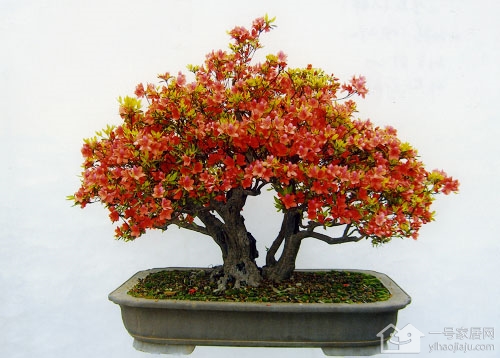Bonsai maintenance of Carthamus tinctorius is embellished in the garden and green space
Carthamus tinctorius has luxuriant branches, graceful posture, resistance to pruning, resistance to flat binding, can be used for hedges, can also be used to make stump bonsai, blooming season, full of safflower, very spectacular. But many people who breed bonsai are prone to bloom disorder and branch loss after a period of time, so the editor will teach you how to maintain it.

1. Maintenance methods of bonsai of Carthamus tinctorius
1. Soil selection
Carthamus tinctorius likes acidic soil, and the soil is too alkaline, which will lead to poor growth and death of bonsai. It is ideal to use river sand, coal ash and yellow loam for breeding safflower wood basin at 3:2:5. It can also be used for river sandy yellow loam at 3:7 or sandy yellow loam, with a layer of well-drained coarse sand or ceramsite in the bottom layer.

2. Pruning and turning the basin
Pruning and shaping is particularly important for cultivating bonsai of Carthamus tinctorius. In order to ensure the ornamental type of bonsai, the overlord branch, long branch, tufted branch, weak branch, pest branch and so on should be cut off during its growth period, and the flowering or red leaf stage can be adjusted by pruning and picking leaves. Heavy shearing should be more appropriate before and after flowering or in early autumn, and the effect of turning the basin is better. Cut off the residual flowers and fruit of Carthamus tinctorius as soon as possible after flowering so as not to consume nutrients.
Turning the basin is beneficial to the growth of Carthamus tinctorius. When turning the basin, we should pay attention to pruning old roots, only growing roots, overlapping roots, disc roots, thinning dense roots, removing rotten roots and withered roots, removing persistent soil and replacing new soil. Turn the interval time to look at the growth of the pile scene, depending on the size of the pot, generally large basin 3-4 years, medium basin 2-3 years, small basin 1-2 years, special circumstances can be carried out at any time.

3. Watering and fertilization
Carthamus tinctorius should be cultivated with big fat and big water. Fertilization adheres to the principle of applying more thin fertilizer, diluting the cake fertilizer and water twice a month during the growing period, occasionally adding 1% urea, spraying 8-1000 times of potassium dihydrogen phosphate solution before flowering can promote flower bud differentiation, enhance flower color, and do not apply fertilizer during flowering and dormant periods. 0.5% ferrous sulfate solution should also be sprayed once a season to keep the soil acidic. Fertilization should be carried out on cloudy or sunny evenings.
The watering of Carthamus tinctorius bonsai should depend on the season, climate, the size of the pot, and the plant growth condition should be flexibly grasped. In principle, every watering must be thoroughly watered to keep the soil moist but not stagnant. In the middle of summer, in addition to watering through the morning and evening and spraying water on the foliar surface, conditions should be appropriate shade to avoid exposure to the roots of the pot wall or burn leaves causing local withering at the edge of the leaves, while high temperature will also make the leaves turn green and affect the ornamental.
4. prevention and control of diseases and insect pests
Carthamus tinctorius has strong resistance to diseases and insect pests, but it is not likely to have black spot, soot, shell insects and other diseases and insect pests in management. Therefore, attention should be paid to the monitoring of diseases and insect pests when breeding safflower trees, and early detection and early treatment should be achieved.
5. Propagation of bonsai of Carthamus tinctorius
There are few wild resources of Carthamus tinctorius, so bonsai Carthamus tinctorius generally adopts the method of grafting. Grafting can be carried out during the growing period, and the survival rate is the highest from April to May. Grafting generally uses stronger branches in the same year, and buds (shoots) can also be used for abdominal grafting or budding.

Second, the florescence of Carthamus roseus
The leaves of Carthamus tinctorius are alternate, the new leaves are light red and the old leaves are dark red. The color of flowers is mainly red, there are light red, pink, crimson, purple red, 4-8 flowers in a bunch, head-shaped or spikes.
The flowering time of Carthamus tinctorius is not particularly fixed, the flowering period in Lingnan is from March to April, and it can blossom one after another in summer and autumn. It will bear fruit after flowering, and the fruit is sauce-colored and has no ornamental value. Remember not to delay.
The above are some sorting methods for the flowering period of safflower and the maintenance of bonsai. I hope it will be helpful to the friends who raise or will breed bonsai. After all, it is also a good scenery for safflower to be placed at home. If you want to know more about maintenance, please continue to follow the No.1 Home Network.
Related
- Wuhan Hospital Iron Tree Blooming Result Was Instantly Frightened by the Gardener Master
- Which variety of camellia is the most fragrant and best? Which one do you like best?
- What is the small blue coat, the breeding methods and matters needing attention of the succulent plant
- Dormancy time and maintenance management of succulent plants during dormancy
- Minas succulent how to raise, Minas succulent plant pictures
- What are the varieties of winter succulent plants
- How to raise succulent plants in twelve rolls? let's take a look at some experience of breeding twelve rolls.
- Attention should be paid to water control for succulent plants during dormant period (winter and summer)
- Watering experience of twelve rolls of succulent plants
- Techniques for fertilizing succulent plants. An article will let you know how to fertilize succulent plants.



